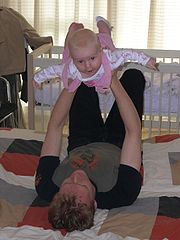
Paternal bond
Encyclopedia


Father
A father, Pop, Dad, or Papa, is defined as a male parent of any type of offspring. The adjective "paternal" refers to father, parallel to "maternal" for mother...
and his child. In the U.S., legal paternity
Paternity (law)
In law, paternity is the legal acknowledgment of the parental relationship between a man and a child usually based on several factors.At common law, a child born to the wife during a marriage is the husband's child under the "presumption of legitimacy", and the husband is assigned complete rights,...
is presumed for the husband of the mother unless a separate action is taken; an unmarried man may establish paternity by signing a voluntary recognition of paternity or by taking court action. Paternity may also be established between a man and a younger person, commonly in adoption
Adoption
Adoption is a process whereby a person assumes the parenting for another and, in so doing, permanently transfers all rights and responsibilities from the original parent or parents...
, without the two being biologically related.
Fatherhood
The father of a child can develop the bond during the pregnancyPregnancy
Pregnancy refers to the fertilization and development of one or more offspring, known as a fetus or embryo, in a woman's uterus. In a pregnancy, there can be multiple gestations, as in the case of twins or triplets...
of his partner
Significant other
Significant other is colloquially used as a gender-blind term for a person's partner in an intimate relationship without disclosing or presuming anything about marital status, relationship status, or sexual orientation, as it is vague enough to avoid offense by using a term that an individual...
, feeling attachment
Attachment theory
Attachment theory describes the dynamics of long-term relationships between humans. Its most important tenet is that an infant needs to develop a relationship with at least one primary caregiver for social and emotional development to occur normally. Attachment theory is an interdisciplinary study...
to the developing child. Research indicates that this may have some biological basis. Statistics show that fathers' levels of testosterone
Testosterone
Testosterone is a steroid hormone from the androgen group and is found in mammals, reptiles, birds, and other vertebrates. In mammals, testosterone is primarily secreted in the testes of males and the ovaries of females, although small amounts are also secreted by the adrenal glands...
tend to decline several months before the birth of the child. Since high testosterone levels seem to encourage more aggressive behaviour, low levels may enhance the ability to develop a new relationship bond (i.e. with the child).
Fathers find many ways to strengthen the father-child bond with their children, such as soothing, consoling, feeding (expressed breast milk
Breast milk
Breast milk, more specifically human milk, is the milk produced by the breasts of a human female for her infant offspring...
, infant formula
Infant formula
Infant formula is a manufactured food designed and marketed for feeding to babies and infants under 12 months of age, usually prepared for bottle-feeding or cup-feeding from powder or liquid . The U.S...
, or baby food
Baby food
Baby food is any food, other than breastmilk or infant formula, that is made specifically for infants, roughly between the ages of four to six months to 2 years. The food comes in multiple varieties and tastes, can be produced by many manufacturers, or may be table food that the rest of the family...
), changing diapers, bathing, dressing, playing, and cuddling. Carrying the infant
Babywearing
Babywearing is the practice of wearing or carrying a baby or child in a sling or other form of carrier. Babywearing is far from new and has been practised for centuries around the world...
in a sling or backpack or pushing him or her in a baby transport
Baby transport
Baby transport consists of devices for transporting and carrying infants. A "child carrier" or "baby carrier" is a device used to carry an infant or small child on the body of an adult...
can build the bond, as can participating in the baby's bedtime routine.
See also
- Father's rights
- Human bondingHuman bondingHuman bonding is the process of development of a close, interpersonal relationship. It most commonly takes place between family members or friends, but can also develop among groups such as sporting teams and whenever people spend time together...
- Cinderella effectCinderella EffectThe Cinderella effect is a term used by psychologists to describe the high incidence of stepchildren being physically abused, emotionally abused, sexually abused, neglected, murdered, or otherwise mistreated at the hands of their stepparents at significantly higher rates than at the hands of their...
- Maternal bondMaternal bondThe maternal bond is typically the relationship between a mother and her child.While it typically occurs due to pregnancy and childbirth, it may also occur between a woman and an unrelated child, such as in adoption...
- Parental leaveParental leaveParental leave is an employee benefit that provides paid or unpaid time off work to care for a child or make arrangements for the child's welfare. Often, the term parental leave includes maternity, paternity, and adoption leave...
- Paternity leave
- Responsible FatherhoodResponsible Fatherhood- The rise of single-parent homes :The number of children living in single-parent households has increased dramatically since the 1960s. Approximately 9% of children under 18 lived with a single parent in 1960; by 2007 this rate increased to nearly 32%...

